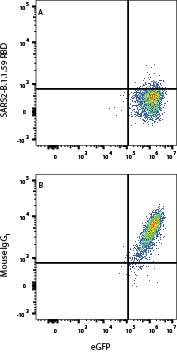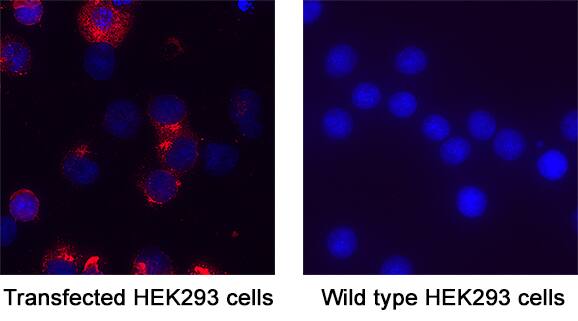SARS-CoV-2 B.1.1.529 (Omicron BA.1) RBD Antibody
R&D Systems, part of Bio-Techne | Catalog # MAB11227

Key Product Details
Species Reactivity
SARS-CoV-2
Applications
Blockade of Receptor-ligand Interaction, Immunocytochemistry
Label
Unconjugated
Antibody Source
Monoclonal Mouse IgG1 Clone # 1056608
Product Specifications
Immunogen
Recombinant SARS-CoV-2 B.1.1.529 (Omicron) Spike RBD domain.
Arg319-Phe541
Accession # YP_009724390.1
Arg319-Phe541
Accession # YP_009724390.1
Specificity
It detects SARS-CoV-2 Omicron BA.1 in Direct ELISA. In ELISA, this antibody does not detect SARS-CoV-2 Alpha, Gamma or Delta variants.
Clonality
Monoclonal
Host
Mouse
Isotype
IgG1
Scientific Data Images for SARS-CoV-2 B.1.1.529 (Omicron BA.1) RBD Antibody
Detection of Spike RBD in HEK293 (positive) and HEK293 wild type (negative) cells.
Spike RBD was detected in immersion fixed HEK293 (positive) and HEK293 wild type (negative) cells using Mouse Anti-SARS-CoV-2 Spike RBD Monoclonal Antibody (Catalog # MAB11227) at 3 µg/mL for 3 hours at room temperature. Cells were stained using the NorthernLights™ 557-conjugated Anti-Mouse IgG Secondary Antibody (red; Catalog # NL007) and counterstained with DAPI (blue). Specific staining was localized to cytoplasm. View our protocol for Fluorescent ICC Staining of Non-adherent Cells.Blocking of Spike RBD in HEK293 cells transfected with Human ACE-2 and eGFP cells by Flow Cytometry.
In a functional flow cytometry test, Recombinant SARS-Cov-2 Spike RBD His-tagged protein (10500-CV) binds to HEK293 human embryonic kidney cell line transfected with recombinant human ACE-2 and eGFP. (A) Binding is blocked by 25µg/mL of Mouse Anti-SARS-CoV-2 Spike RBD Monoclonal Antibody (Catalog # MAB11227) but not by (B) Mouse IgG1 Isotype Control (Catalog # MAB002). Protein binding was detected with His Tag Allophycocyanin Mab (Catalog # IC050A). View our protocol for Staining Membrane-associated Proteins.Applications for SARS-CoV-2 B.1.1.529 (Omicron BA.1) RBD Antibody
Application
Recommended Usage
Blockade of Receptor-ligand Interaction
In a functional flow cytometry test, 25 μg/mL of Mouse Anti-SARS-CoV-2 Spike RBD Monoclonal Antibody (Catalog # MAB11227) will block the binding of Recombinant SARS-Cov-2 Spike RBD His-tagged protein (Catalog # 10500-CV) to HEK293 human embryonic kidney cell line transfected with recombinant human ACE-2 and eGFP
Immunocytochemistry
3-25 µg/mL
Sample: Immersion fixed HEK293 (positive) and HEK293 wild type (negative) cells
Sample: Immersion fixed HEK293 (positive) and HEK293 wild type (negative) cells
Please Note: Optimal dilutions of this antibody should be experimentally determined.
Formulation, Preparation, and Storage
Purification
Protein A or G purified from cell culture supernatant
Reconstitution
Reconstitute at 0.5 mg/mL in sterile PBS. For liquid material, refer to CoA for concentration.
Formulation
Lyophilized from a 0.2 μm filtered solution in PBS with Trehalose. *Small pack size (SP) is supplied either lyophilized or as a 0.2 µm filtered solution in PBS.
Shipping
Lyophilized product is shipped at ambient temperature. Liquid small pack size (-SP) is shipped with polar packs. Upon receipt, store immediately at the temperature recommended below.
Stability & Storage
Use a manual defrost freezer and avoid repeated freeze-thaw cycles.
- 12 months from date of receipt, -20 to -70 °C as supplied.
- 1 month, 2 to 8 °C under sterile conditions after reconstitution.
- 6 months, -20 to -70 °C under sterile conditions after reconstitution.
Background: Spike RBD
References
- Wu, F. et al. (2020) Nature 579:265.
- Tortorici, M.A. and D. Veesler (2019) Adv. Virus Res. 105:93.
- Bosch, B.J. et al. (2003) J. Virol. 77:8801.
- Belouzard, S. et al. (2009) Proc. Natl. Acad. Sci. 106:5871.
- Millet, J.K. and G.R. Whittaker (2015) Virus Res. 202:120.
- Li, W. et al. (2003) Nature 426:450.
- Wong, S.K. et al. (2004) J. Biol. Chem. 279:3197.
- Jiang, S. et al. (2020) Trends. Immunol. https://doi.org/10.1016/j.it.2020.03.007.
- Ortega, J.T. et al. (2020) EXCLI J. 19:410.
- Wrapp, D. et al. (2020) Science 367:1260.
- Tai, W. et al. (2020) Cell. Mol. Immunol. 17:613.
- Okba, N.M.A. et al. (2020). Emerg. Infect. Dis. https://doi.org/10.3201/eid2607.200841.
- Shah, M. and H.G. Woo (2022) Front. Immunol. https://doi.org/10.3389/fimmu.2021.830527.
- Lupala, C.S. et al. (2021) Biochem. Biophys. Res. Comm. (2022) https://doi.org/10.1101/2021.12.10.472102.
Long Name
Spike Receptor Binding Domain
Gene Symbol
S
UniProt
Additional Spike RBD Products
Product Documents for SARS-CoV-2 B.1.1.529 (Omicron BA.1) RBD Antibody
Product Specific Notices for SARS-CoV-2 B.1.1.529 (Omicron BA.1) RBD Antibody
For research use only
